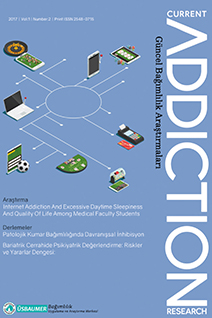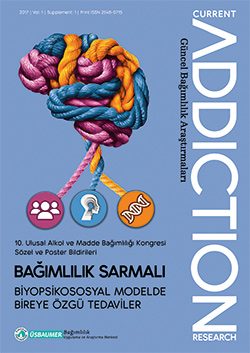Years
2017
Categories
Authors
- Ahmet Yılmaz (1)
- Alptekin Çetin (1)
- Aslı Enez Darçın (1)
- Aslıhan Polat (1)
- Cemal Onur Noyan (3)
- Erkal Erzincan (1)
- Erol Göka (1)
- Fatma Eren (1)
- Gürler Güz (1)
- Hasan Kaya (3)
- Hatice Turan (1)
- Hatice Özyıldız Güz (1)
- Nermin Gündüz (1)
- Nesrin Dilbaz (5)
- Onur Gökçen (1)
- Salih Cihat Paltun (1)
- Serdar Nurmedov (1)
- Zeynep Ülke (1)
- Çelik Hüseyin (1)
- Özge Timur (1)
- Özlem Bolat Kaya (1)
- Şafak Yalçın Şahiner (1)
ARTICLES
Review Article
Nesrin Dilbaz
2017, 1(2), s:53-55
The prevalence of obesity has been growing on a global scale and almost all health caregivers has been involved in its treatment and management. Bariatric surgery has emerged as an effective approach for weight reduction and associated with improved general health. Preoperative psychiatric assessment for bariatric candidates is necessary since the importance is well established. Also empirical data suggest that a high prevalence of psychiatric comorbidities among bariatric surgery candidates. Research indicates a decrease in certain psychiatric symptoms after weight loss with bariatric surgery. However, the risk of unsuccessful weight loss and suicide in some bariatric surgery patients make monitoring after surgery as important as the careful assessment and management before surgery. Neverthless, this area needs a standard protocol to guide the mental health professionals that deal with bariatric patients. In this review, we focus on the management of bariatric surgery patients both preoperatively psychiatric assessment and postoperatively psychiatric follow up.
Original Article
Nermin Gündüz,Özge Timur,Erkal Erzincan,Hatice Turan,Onur Gökçen,Fatma Eren,Aslıhan Polat
2017, 1(2), s:56-63
Objective: Considering the increasing use of the internet among university students, medical faculty students are thought to be particularly sensitive because of the time they spend on the internet and because of intensive practical and theoretical course schedules. In this study, we aimed to examine the prevalence of internet addiction and also relationship between internet addiction and excessive daytime sleepiness and quality of life. among the medicine faculty students. We aimed to examine the prevalence of internet addiction and also relationship between internet addiction and excessive daytime sleepiness and quality of life among medical faculty students.
Method: This study was carried out among the students of Erzurum Atatürk University Medical Faculty. In this cross-sectional study, sociodemographic data form created by researchers, Young Internet Addiction Scale, SF-36 and Epworth Sleepiness Scale were applied after the signing of the voluntary affirmation document to the medical faculty students.
Results: A total of 274 medical faculty students from various classes were included in the study. 61,32% of the students were found to have internet addiction. 53.28% of them were at mild level, 8,04% of them were at moderate level. There was a positive correlation between internet addiction scale total score and epworth sleepiness scale total score. There was negative correlation between internet addiction and each subscale of SF 36.
Conclusion: This study is the first study to evaluate internet addiction, excessive daytime sleepiness and quality of life among medical faculty students. In our study group internet addiction was determined as one of the reasons for excessive daytime sleepiness. That’s why we must focus on the treatment of internet addiction which is a serious problem in social context in recent years.
Review Article
PATOLOJİK KUMAR BAĞIMLILIĞINDA DAVRANIŞSAL İNHİBİSYON
Gürler Güz,Hatice Özyıldız Güz
2017, 1(2), s:65-71
The gambling disorder was removed from impulse control disorders brought to the head of substance and related disorders with DSM-5. It is one of the reasons for this change to be seen in gambling disorders of malpractice processes in the reward and punishment systems seen in substance use disorders. In the development and maintenance of pathological gambling addiction, it has been shown that inhibition of behavior has an important role rather than impulsivity. Delay in suppression is one of the executive functions and is mainly due to prefrontal dysfunction. For this reason, investigations also examined brain functions in gamblers.
Case Report
NALTREKSON CİLT ALTI İMPLANT UYGULAMASI SONRASI GELİŞEN CİLT REAKSİYONU
Salih Cihat Paltun,Şafak Yalçın Şahiner,Hasan Kaya,Erol Göka
2017, 1(2), s:72-72
Naltrexone subcutaneous implants are among the new alternatives in the treatment of alcohol and opioid addictions in our country.Nausea, vomitting, headache, skin rash, depression, anxiety and loss of energy are side effects reported in the use of naltrexone. This paper discusses a case of itching and skin eruptions following the application of naltrexone subcutaneous implant.
Case Report
“TILL PETHIDINE DO US APART”; ADDICTED HEALTHCARE PROFESSIONAL COUPLE
Alptekin Çetin,Ahmet Yılmaz,Cemal Onur Noyan
2017, 1(2), s:75-77
Pethidine(Meperidine) is a synthetic opioid analgesic of the phenylpiperidine class. Since 1940ies, addictive potential of pethidine was documented in many reports. Pethidine addiction is also common among medical doctors and nurses. We present clinical features and treatment response of a married couple, a gastroenterologist and a nurse who were admitted with pethidine addiction. A 34-year-old male(a gastroenterologist) and a 26-year-old female(a nurse) married couple were admitted to clinic with the use of pethidine intravenously. While male patient refused treatment, female patient continued her treatment in inpatient service. Healthcare professionals have to be cautious while using and prescribing drugs with addiction potential. Surgeons, anesthesiologists, gastroenterologists psychiatrists and surgical nurses are the risk groups for dependency among those professionals.
Editorial
Nesrin Dilbaz
2017, 1(1), s:9-11
Editorial
Çelik Hüseyin
2017, 1(1), s:13-15
Original Article
Zeynep Ülke,Cemal Onur Noyan,Nesrin Dilbaz
2017, 1(1), s:16-25
Objective: The objective of this study was to adapt the “Bergen Facebook Addiction Scale (BFAS)” developed by Adreassen et al (1) into Turkish, and to evaluate the reliability and validity of the Turkish version of the Bergen Facebook Addiction among university students.
Method: The study was conducted in 2015 at Uskudar University and Yeditepe University (Istanbul-Turkey) with a total of 300 students from different majors and age groups. The draft scale was finalized after being translated and corrected by experts in the relevant fields. To determine the validity of the scale; factor analysis was performed and the results revealed that, of the 6 items reflecting the six core elements. It was detected that all items were distinctive with respect to relationship of each item with its related factor. Reliability level was determined by test – retest and internal consistency analysis. In addition, to test the criterion dependence validity of the scale, the correlation between the data gathered from Bergen Facebook Addiction Scale was analyzed respectively with data collected from the Smartphone Addiction Scale, Facebook Use Variance and Facebook Addiction Self-evaluation.
Results: The internal consistency coefficient was calculated using the Cronbach’s Alpha formula and gave a result of crα= .89. The 3-week test-retest validity Cronbach’s alpha was .76 for the six-item Bergen Facebook Addiction Scale. The factor analysis and testretest results confirmed the reliability and validity of the 6-item scale.
Conclusion: Bergen Facebook Addiction Scale is able to measure reliably, and the scale is a valid and reliable tool to be employed in a clinical environment to predict addiction levels of individuals regarding Facebook use in the Turkish society as well.
Original Article
Treatment And Approaches On Acute Agitation Among in Patients in a Private Psychıatry Hospital
Aslı Enez Darçın,Cemal Onur Noyan,Serdar Nurmedov,Hasan Kaya,Nesrin Dilbaz
2017, 1(1), s:26-32
Aim: It is aimed to determine the association between the indications of acute agitation call, applied treatment, applied restraint and seclusion with the
sociodemographical and clinical characteristics of psychopathology.
Method: Among inpatients in a private psychiatry hospital, medical records of whom has a form filled for acute agitation between June 2013-April 2014 examined
retrospectively, 137 medical records enrolled. Acute intervation form and brief psychiatric rating scale points that had been filled in the same day were determined.
Results: In the duration of the study acute agitation call applied for 16.4% of inpatients, 1.9% were restrained, 8% were secluded and 9.4% were given acute medication.
While the applied physical restraint and seclusion rates did not differ during the day, drug applications were found in higher rates during daytime hours (p<0.05). According to the hours of application, the duration of physical restraints were constant throughout the day while the duration of seclusions were longer in the night hours (p<0.05). The most common causes of acute agitation were aggression, threat of violence and treatment rejection. There was no difference approaches to acute agitation in terms of the diagnosis. The majority of selected drug treatments for acute agitation were intramuscular injections. No association was found between scale scores and the duration of any application.
Conclusion: Lower rates of restraints in our study could be associated with that the sample of this study was chosen from a private psychiatry hospital. There is need
for further training among treatment team and studies in this area to shed light on the development of approaches.
Review Article
Genetics Of Alcohol Use Disorder
Hasan Kaya,Özlem Bolat Kaya,Nesrin Dilbaz
2017, 1(1), s:33-46
Introduction: Alcohol Use Disorder (AUD) is a chronic
psychiatric disorder characterizes by harmful drinking
patterns leading to negative emotional, physical, and
social outcomes. Twin, family, and adoption studies
have consistently demonstrated that genetic factors
play a critical role in the pathogenesis of AUD. Various
studies have aimed to identify genes that contribute
to susceptibility to AUD. In this paper, we provide
an review of genetic studies on AUD, including twin
studies, linkage studies, candidate gene studies, and
genome-wide association studies (GWAS). Growing
evidence indicates that AUD is a complex genetic
disease, with variations in a substantial number of gene
affecting a person’s risk of AUD. Some of these genes
have been identified, including two genes involved in the
metabolism of ethanol (ADH1B and ALDH2) that have
the strongest known affects on the risk of AUD. Studies
continue to find out other genes in which variants affect
the risk of AUD or related traits, including GABRA2,
DRD2, OPRM1, MAOA and PECR. As more variants
are analysed and studies are integrated for meta-analysis
to obtain increased sample sizes, an enhanced picture of
the many genes and pathways that affect the risk of AUD
will be possible.



 2. Sayı
2. Sayı
 1. Sayı
1. Sayı
 Ek Sayı
Ek Sayı







